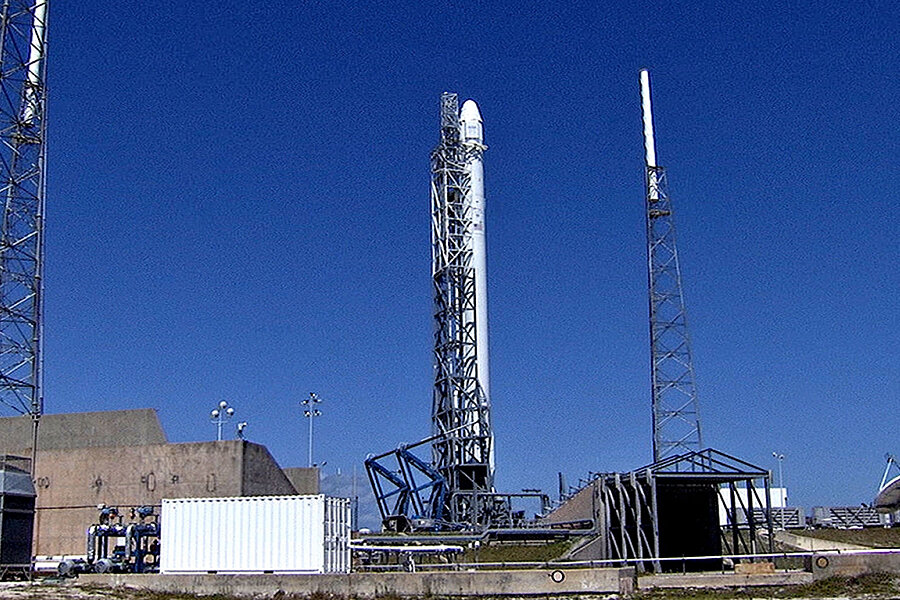SpaceX launch to space station: It's what is coming down that's key
Loading...
All eyes are on the weather as Space Exploration Technology Corp. (SpaceX) gets set to launch nearly 2.5 tons of cargo to the International Space Station and conduct the first test of a new landing system designed to return the first stage of the company's Falcon 9 rocket to its launch pad.
The launch is scheduled for 3:25 p.m. Eastern Daylight Time Friday, but unsettled weather over and around the launch site at Cape Canaveral Air Force Station in Florida has put the odds of a launch at 40 percent.
The cargo ranges from crew supplies to experiments designed to test a laser-based space communications system, hardware for growing vegetables in space, and a microbiology experiment that researchers hope will yield insights into why long-duration spaceflight reduces the effectiveness of the human immune system.
In addition, the station's seventh crew member, NASA's Robonaut 2, is slated to receive its first pair of legs, "but not like legs any human has ever had," Andy Petro, who heads NASA's space-technology directorate, noted at a prelaunch briefing earlier this week.
The new appendages give the humanoid robot a look blending a Power Ranger's head and torso with legs that look like NASA raided the lair of Spiderman's nemesis, Dr. Octopus. Each leg has seven joints, allowing them to assume shapes that would make an experienced contortionist wince. Instead of feet, the legs sport clamps at the end, which will allow the robot to cling to the station – inside or out – while leaving hands free for work.
But for sheer technological splash, few of this mission's objectives match the landing system that SpaceX is developing in hopes of driving down the cost of launching payloads to space. While the company's Dragon space capsules are reusable, it still has to build and essentially throw way the first stage of its Falcon 9 rocket.
A major step in reducing launch costs is bringing the first stage under its own power back for refurbishment and reuse, company officials say.
SpaceX engineers have successfully put a landing system through its paces on an experimental rocket dubbed "Grasshopper" at the company's test facility at McGregor, Texas. Friday’s launch marks the first time the technology, which includes four 25-foot legs that sprout from the base of the first stage, has been incorporated into an operational mission.
For this test, the landing site remains the Atlantic Ocean, rather than the launch pad.
And company officials are trying to keep expectations in check.
The attempt at a soft landing into the ocean has a 30 to 40 percent chance of succeeding, cautioned Hans Koenigsmann, the company's vice-president for mission assurance, at a recent pre-launch briefing. "We will be super thrilled" if the first stage merely clears the first step in its powered descent – an engine burn aimed at orienting the stage to begin its descent.
For its part, NASA is satisfied that the system has enough safeguards to prevent the legs from inadvertently deploying during the rocket's rise through the atmosphere, said Michael Suffredini, who heads NASA's International Space Station program.
Moreover, the system is sufficiently light to have "no appreciable impact" on the amount of cargo the capsule can carry, he said.
Whether a fully reusable rocket can lower launch costs remains to be seen, notes James Cutler, an assistant professor of aerospace engineering at the University of Michigan at Ann Arbor. Much depends on the pace at which the rockets are launched and the value of the payloads.
The space shuttle's initial launch-cost estimates assumed that the Pentagon would be a regular long-term customer and that demand would drive a schedule that required a launch a week. Neither turned out to be the case, driving the launch costs to upwards of $10,000 a pound.
Once-and-done rockets become prohibitively expensive if the spacecraft are relatively small and inexpensive – a direction that tight federal budgets appear to be driving many space missions.
Under these circumstances, reusable craft could play an important role, Dr. Cutler says, adding, "It's a very interesting time" for the industry.








